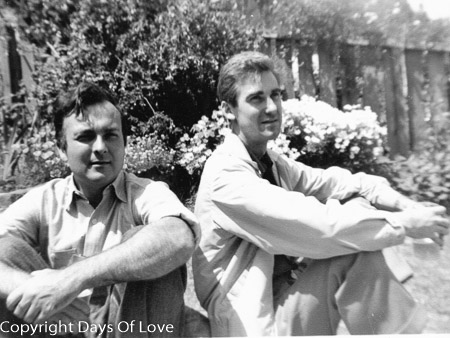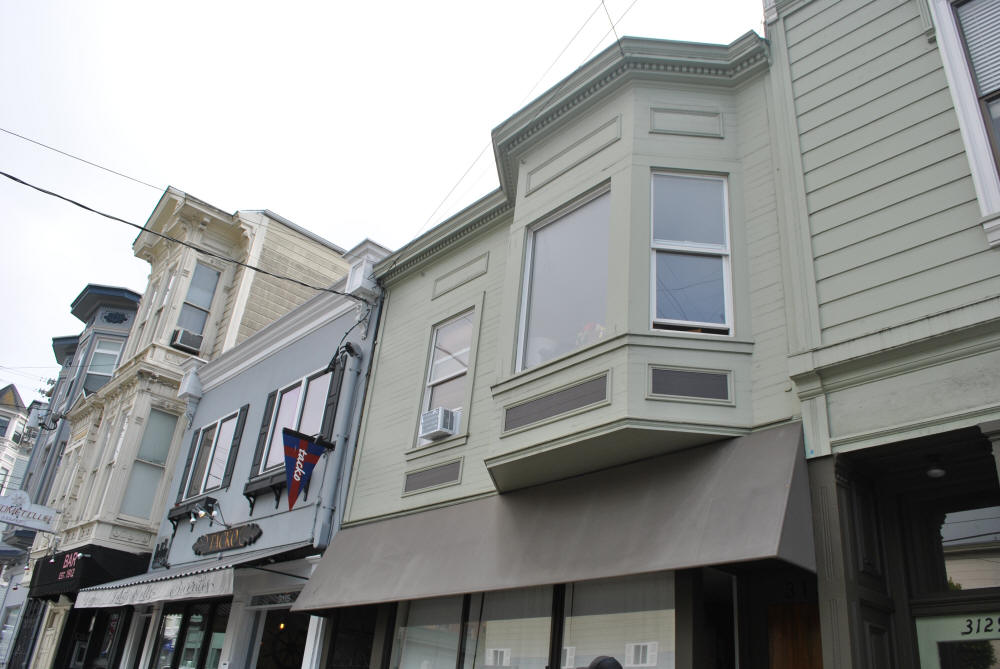Partner Werner Vordtriede, Jess Collins
Queer Places:
University of California, Berkeley, California, Stati Uniti
Black Mountain College, Black Mountain, NC 28711, Stati Uniti
Six Gallery, 3119 Fillmore St, San Francisco, CA 94123, Stati Uniti
42 Pearl St, Provincetown, MA 02657
2029 Hearst Ave, Berkeley, CA 94709
 Robert
Edward Duncan[1] (January 7, 1919 in Oakland, California – February 3, 1988)[2] was an American poet and a devotee of H.D. and the Western esoteric tradition who spent most of his career in and around San Francisco. Though associated with any number of literary traditions and schools, Duncan is often identified with the poets of the New American Poetry and Black Mountain College. Duncan saw his work as emerging especially from the tradition of Pound, Williams and Lawrence. Duncan was a key figure in the San Francisco Renaissance.
A young Robert Duncan had a brief affair with German emigrant poet - professor
Werner Vordtriede .
Robert
Edward Duncan[1] (January 7, 1919 in Oakland, California – February 3, 1988)[2] was an American poet and a devotee of H.D. and the Western esoteric tradition who spent most of his career in and around San Francisco. Though associated with any number of literary traditions and schools, Duncan is often identified with the poets of the New American Poetry and Black Mountain College. Duncan saw his work as emerging especially from the tradition of Pound, Williams and Lawrence. Duncan was a key figure in the San Francisco Renaissance.
A young Robert Duncan had a brief affair with German emigrant poet - professor
Werner Vordtriede .
Not only a poet, but also a public intellectual, Duncan's presence was felt across many facets of popular culture. Duncan’s name is prominent in the history of pre-Stonewall gay culture and in the emergence of bohemian socialist communities of the 1930s and '40s, in the Beat Generation, and also in the cultural and political upheaval of the 1960s, influencing occult and gnostic circles of the time. During the later part of his life, Duncan's work, published by City Lights and New Directions, came to be distributed worldwide, and his influence as a poet is evident today in both mainstream and avant-garde writing.[3]
Duncan was born in Oakland, California, as Edward Howard Duncan Jr. His mother, Marguerite Pearl Duncan, had died in childbirth and his father was unable to afford him, so in 1920 he was adopted by Edwin and Minnehaha Symmes, a family of devout Theosophists. They renamed him Robert Edward Symmes; it was only after a psychiatric discharge from the army in 1941 that he formed the composite of his previous names and became Robert Edward Duncan.

3119 Fillmore St, San Francisco, CA
The Symmeses had begun planning for the child's arrival long prior to his adoption. There were terms for his adoption that had to be met: he had to be born at the time and place appointed by the astrologers, his mother was to die shortly after giving birth, and he was to be of Anglo-Saxon Protestant descent.[4] His childhood was stable, and his parents were popular and social members of their community—Edwin was a prominent architect and Minnehaha devoted much of her time to volunteering and serving on committees. He grew up surrounded by the occult in one form or another; he was well aware of the circumstances of his fated birth and adoption and his parents carefully interpreted his dreams. The family adopted a second child, Barbara Eleanor Symmes, in 1920. She was born one year minus one day after Duncan, on January 6, 1920. She also was selected under circumstances similar to that of her brother; her presence was expected to bring good karma into the family.
At age three, Duncan was injured in an accident on the snow that resulted in his becoming cross-eyed and seeing double. In ''Roots and Branches'', his second major book, he wrote: "I had the double reminder always, the vertical and horizontal displacement in vision that later became separated, specialized into a near and a far sight. One image to the right and above the other. Reach out and touch. Point to the one that is really there."
After the death of his adopted father in 1936, Duncan started studying at the University of California, Berkeley. He began writing poems inspired in part by his left wing politics and acquired a reputation as a bohemian. His friends and influences included Mary and Lilli Fabilli, Virginia Admiral,and Pauline Kael, among others. He thrived as storyteller, poet, and fledgling bohemian, but by his sophomore year he had begun to drop classes and had quit attending obligatory military drills.
In 1938, he briefly attended Black Mountain College, but left after a dispute with faculty over the Spanish Civil War. He spent two years in Philadelphia and then moved to Woodstock, New York to join a commune run by James Cooney, where he worked on Cooney's magazine ''The Phoenix'' and met both Henry Miller and Anaïs Nin.
While living in Philadelphia, Duncan had his first recorded homosexual relationship with an instructor he had first met in Berkeley, Ned Fahs. In 1941 Duncan was drafted and declared his homosexuality to get discharged. In 1943, he had his first heterosexual relationship, which ended in a short, disastrous marriage. In 1944 Duncan had a relationship with the abstract expressionist painter Robert De Niro Sr.[5]
Duncan's name figures prominently in the history of pre-Stonewall gay culture. In 1944, Duncan wrote the landmark essay ''The Homosexual in Society''. The essay, in which Duncan compared the plight of homosexuals with that of African Americans and Jews, was published in Dwight Macdonald's journal ''politics''. Duncan's essay is considered a pioneering treatise on the experience of homosexuals in American society given its appearance a full decade before any organized gay rights movement (Mattachine Society). In 1951 Duncan met the artist Jess Collins and began a collaboration and partnership that lasted until Duncan's death 37 years later.
Duncan returned to San Francisco in 1945 and was befriended by Helen Adam, Madeline Gleason, and Kenneth Rexroth (with whom he had been in correspondence for some time). He returned to Berkeley to study Medieval and Renaissance literature and cultivated a reputation as a shamanistic figure in San Francisco poetry and artistic circles.
When the San Francisco poet Robert Duncan met fellow poet
Jack Spicer in 1946, one of their
first conversations was about Stefan George’s
Maximin cult. Duncan had been having an affair with
Werner Vordtriede, who had
had childhood connections with the George Kreis. As it happens, Spicer was
studying medieval history with
Ernst Kantorowicz. Spicer saw in Duncan an opportunity to set up an
American version of the Kreis. Duncan moved into a communal household at 2029
Hearst Street, Berkeley, where nocturnal poetry readings and workshops were
soon instituted. On a visit to Berkeley,
E.M. Forster called in on 2029, but
he was unresponsive to the young poets until they served him tea and gin.
Duncan's first book, ''Heavenly City Earthly City'', was published by Bern Porter in 1947. In the early 1950s he started publishing in Cid Corman's ''Origin'' and the ''Black Mountain Review'' and in 1956 he spent a time teaching at the Black Mountain College. ''Robert Duncan in San Francisco'' by Michael Rumaker, originally published in 2001, tells of this part of Duncan's life.
During the 1960s, Duncan achieved considerable artistic and critical success with three books; ''The Opening of the Field'' (1960), ''Roots and Branches'' (1964), and ''Bending the Bow'' (1968). These are generally considered to be his most significant works. His poetry is modernist in its preference for the impersonal, mythic, and hieratic, but Romantic in its privileging of the organic, the irrational and primordial, the not-yet-articulate blindly making its way into language like salmon running upstream:
Neither our vices nor our virtues
further the poem. "They came up
and died
just like they do every year
on the rocks."
The poem
feeds upon thought, feeling, impulse,
to breed itself,
a spiritual urgency at the dark ladders leaping.
''The Opening of the Field'' begins with "Often I Am Permitted to Return to a Meadow", suggesting one interpretation of "Field" in the title.[6] The book includes short lyric poems, a recurring sequence of prose poems called "The Structure of Rime," and a long poem called "Poem Beginning with a Line by Pindar". The long poem draws materials from Pindar, Francisco Goya, Walt Whitman, Ezra Pound, Charles Olson, and the myth of Persephone into an extended visionary and ecstatic fugue in the mode of Pound's ''Pisan Cantos''.
The American poet Louis Zokofsky in 1969 wrote an extraordinary set of homophonic translations of
Catullus that attempted in English to replicate the sound as primary emphasis, rather than the more common emphasis on sense of the originals (although the relationship between sound and sense there is often misrepresented and has been clarified by careful study); his Catullus versions have had extensive influence on contemporary innovative poetry and homophonic translation, including the work of poets
Robert Duncan,
Robert Kelly, and
Charles Bernstein.
After ''Bending the Bow'', Duncan vowed to avoid the distraction of publication for fifteen years. His friend and fellow poet Michael Palmer writes about this time in his essay "Ground Work: On Robert Duncan": The story is well-known in poetry circles: around 1968, disgusted by his difficulties with publishers and by what he perceived as the careerist strategies of many poets, Duncan vowed not to publish a new collection for fifteen years. (There would be chapbooks along the way.) He felt that this decision would free him to listen to the demands of his (supremely demanding) poetics and would liberate the architecture of his work from all compromised considerations. ...It was not until 1984 that ''Ground Work I: Before the War'' appeared, for which he won the National Poetry Award, to be followed in February 1988, the month of his death, by ''Ground Work II: In the Dark''."[7]
My published books:


BACK TO HOME PAGE

- ^ Robert Duncan (poet), From Wikipedia, the free encyclopedia
- Woods, Gregory. Homintern . Yale University Press. Edizione del
Kindle.
 Robert
Edward Duncan[1] (January 7, 1919 in Oakland, California – February 3, 1988)[2] was an American poet and a devotee of H.D. and the Western esoteric tradition who spent most of his career in and around San Francisco. Though associated with any number of literary traditions and schools, Duncan is often identified with the poets of the New American Poetry and Black Mountain College. Duncan saw his work as emerging especially from the tradition of Pound, Williams and Lawrence. Duncan was a key figure in the San Francisco Renaissance.
A young Robert Duncan had a brief affair with German emigrant poet - professor
Werner Vordtriede .
Robert
Edward Duncan[1] (January 7, 1919 in Oakland, California – February 3, 1988)[2] was an American poet and a devotee of H.D. and the Western esoteric tradition who spent most of his career in and around San Francisco. Though associated with any number of literary traditions and schools, Duncan is often identified with the poets of the New American Poetry and Black Mountain College. Duncan saw his work as emerging especially from the tradition of Pound, Williams and Lawrence. Duncan was a key figure in the San Francisco Renaissance.
A young Robert Duncan had a brief affair with German emigrant poet - professor
Werner Vordtriede .

